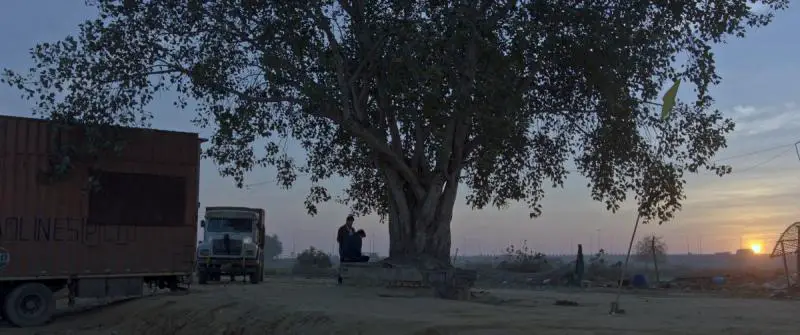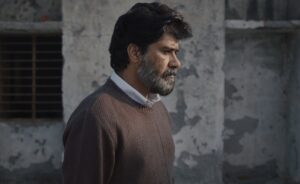Chronic back pain. Ghost of a dead wife. 500000 kilometres of rumbling. Long lost friends. In reverse chronological order, this is truck driver Ghalib’s life in Ivan Ayr’s second feature film, Meel Patthar. Like his first feature Soni, this one also opened in Venice Film Festival’s Orrizonti (Horizon) section.
Meel Patthar (Milestone in English) is a study of insignificant lives. Ghalib has recently crossed the 500000 kilometres milestone – the first and only one to do so. Ironically, he is just as much lonely in his real life as he is in his achievements, if not more. Too often, I was reminded of Gulzar’s lines –
saañs lenā bhī kaisī aadat ha
i jiye jaanā bhī kyā rivāyat hai
A Tale of Paradoxes
Ghalib’s life is a strange tale of paradoxes. He knows he is alive, but he does not know what it means to be alive. He is a working-class hero among the younger truck drivers, the one who has dedicated his whole life to work. But he is not the Fern of Nomadland, neither is he the Bimal of Ajantrik. He does what he does out of compulsion. He is the Travis of Taxi Driver; loneliness has followed him everywhere, his whole life. He says he has been doing double duty since his wife’s death, but why? Does he know that himself? Perhaps he does. Indeed, in one strikingly moving scene, he laments, “The helplessness is that this is all I am.”
He always knew he loved his wife, but now, he is not so sure what love is. His wife is dead, but her memories are very much alive – a solitary picture of Dalai Lama hanging on the wall (she was Buddhist), empty flower pots which she loved to have painted. There is also a slight hint of infidelity. Perhaps, Ghalib was actually married to his work rather than his wife.
Migration, Identity and Politics
Ivan also touches on issues like migration, identity and politics. Ghalib was born in Kuwait, moved to Punjab, married a Sikkimese and relocated to Delhi. His truck is registered in UP. In the end, he does not belong anywhere. He is a ‘shehri’ at his ancestral village. He is just like any other migrant in this potpourri of labourers, workers, and daily wage earners, that is Delhi. So, is his Kashmiri neighbour, who talks fondly about shovelling snow at her home. The Union leader is from Bihar, whose family is back home waiting for him to send money. However, this melange of language and diverse culture plays out very soothingly because of its rarity in mainstream films.
In one scene, we see Ghalib confronting a young Union leader, who has called on a workers’ strike. The irony is that Ghalib is a worker too eking out a precarious existence, so are the other drivers. Ghalib has become an old-timer himself; his khalasi Pash will replace him very soon. The class division within the working class is very much evident. But, it is not a political film, nor is it didactical. Rather Ivan aims to touch our own subconscious political understanding of fissures and fractures within our neatly woven social reality.
Metaphorical Marvel
Screenwriter Neel Manikant and Ivan chose to permeate the film with lyrical dialogues and metaphors. Ghalib’s back pain is the most pronounced of them. Ivan chose to shoot in long, slow takes Ghalib’s walking away from us with a hand on his back. It seemed like Ghalib was indirectly telling us that he was too tired and had grown weary of his life. More significant ones are hidden within the normal conversations like “tike hi nahin”, “bura waqt hai ji!”, “bhatere meel aane hain abhi.”
Naming the characters Ghalib (Suvinder Vicky) and Pash (Lakshvir Saran) was also a deliberate choice. Mirza Ghalib was a legendary Urdu poet, and Avtar Singh Pash was a revolutionary Punjabi poet killed in 1988. Our Ghalib is not a poet. But, he could have been. Ivan Ayr said in an interview that initially, he thought of making Ghalib an aspiring poet. But, he dropped the idea because it would have been unrealistic. True, not all those who are lost are poets. But, he went on with the names to show how little these two names mean to us now. Casting Amir Aziz was also a coincidence. Although he shot to fame in 2020 when Roger Waters recited his poetry in a live show, he was a thespian when Ivan approached him.
Visual Splendor

Ivan said in the same interview that he believes more in visual poetry. DOP Angello Faccini compliments his style. Interior shots are shot in low light. Ivan’s minimalist approach pairs perfectly with Angello’s long still shots of empty spaces. Exteriors, too, are mostly night shots with yellow streetlights or subdued pre-dawn greyish sky.
Like the conspicuous absence of his wife, corporeal or otherwise, the background music or lack of it thereof is also very striking. Barring two occasions of Punjabi folk songs, only the rumbling cadence and ‘musical’ horns of trucks serve as the background score. Which is why the piano waltz at the end feels so cathartic.
Like the lingering waltz, the poignancy of Meel Patthar will stay with you long afterwards. Maybe life is an endless flow of time incomprehensible to mortal humans. To quote Gulzar again,
ik safar hai jo bahtā rahtā h
ai kitne barsoñ se kitnī sadiyoñ
se jiye jaate haiñ jiye jaate hai
ñ ādateñ bhī ajiib hotī haiñ
Rating: 4/5
Where to watch: Netflix

